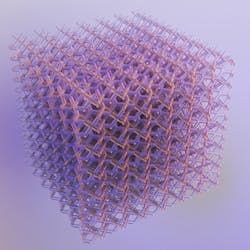Shaping Sustainability in 3D Printing
In a conversation with Dr. Elissa Ross, co-founder and CEO of Metafold, the developer of a Design for Additive Manufacturing (DfAM) cloud-based software, Machine Design learns about the company’s beginnings, the technology behind its computation engine, its impact on key markets and its commitment to sustainability.
Metafold originated two-and-a-half years ago as a spinoff from a consulting business called MESH Consultants Inc., which was launched by one of the co-founders, Daniel Hambleton, a mathematician who is the company’s CTO. The third co-founder, Tom Reslinski, is an architect and Metafold’s COO. Together, they leveraged the expertise of mathematicians and professionals in architecture, engineering and construction, and launched Metafold with a mission to provide digital infrastructure for 3D printing.
A mathematician by training, Ross says they recognized the need for new digital tools to support 3D printing manufacturing technology and address the limitations of traditional CAD systems.
“[CAD systems] were developed for conventional manufacturing, and they are excellent in those capacities,” she says. “But when it comes to supporting high complexity, geometry—that is…what 3D printing is really great at—those same digital tools are traditional CAD tools. They don’t offer what we need.” This new technology addresses that, she says.
READ MORE: Expanding the Definition of Digital Transformation
Platform’s Core is its Geometry Computation Engine
At the center of Metafold’s platform is its geometry computation engine, which Ross says enables the design and optimization of complex geometries for 3D printing. The web application offers capabilities for creating lattice geometries, lightweight parts and high-surface area structures, she explains, and this opens possibilities for a range of industries where optimized structures are highly valuable.
One of the key strengths, she notes, is the material and process agnosticism. Users can access the software via the cloud and API, regardless of the hardware used for 3D printing. This flexibility allows manufacturers to optimize their additive manufacturing processes, whether designing lightweight aerospace parts or creating efficient heat exchangers.
“What we have come to learn and recognize is that in 3D printing, it’s not enough to be…in a very small box,” Ross says. “Customers are at a variety of different places in their additive manufacturing adoption journey. We need to meet them where they are at. So sometimes that involves just kind of helicoptering in and providing that design and geometry support, and other times that means really working out that combination of design for additive, the material, the process, even the post-process. How is it all going to fit together to provide the solution they’re looking for?”
Commitment to Sustainability
At the forefront of Metafold’s mission is its commitment to sustainability. By providing advanced geometry support, the company enables manufacturers to reduce raw material usage and produce lightweight and energy-efficient parts. With 3D printing’s ability to optimize structures and increase surface area, industries such as biopharmaceuticals, process heating and carbon capture devices can benefit.
“Where I think additive manufacturing has so much potential in the sustainability space is in these process improvements,” Ross says. “It’s in creating those better heat exchangers. Another amazing example is in carbon capture devices…the more surface you put in contact with air, the more carbon you can pull from the air. So, 3D printing and its ability to produce these high-surface area highly optimized structures…[is] where the key potential for highly sustainable impacts [is] for 3D printing.”
To help manufacturers realize these sustainable impacts, Ross says, “We absolutely need better digital tools so that we can plan them and design them and then finally execute them…We like to say that we help our customers become more competitive and more sustainable, because at the end of the day these things go hand in hand.”
Metafold also recognizes the interplay between sustainability and competitiveness, helping customers to achieve both by choosing the additive manufacturing use cases that make sense economically and environmentally.
Large organizations are under a lot of pressure to improve their sustainability, especially in the manufacturing department, Ross notes. “But this needs to come with…a competition argument, a financial kind of bottom line, and we’re here to support that…In other words, we choose the use cases of additive that really make sense,” she says.
Software Integration, Looking Ahead
Metafold’s subscription-based web application receives continual updates due to its cloud-based nature. The company offers free access for non-commercial use in education and supports startups working on clean tech problems.
When asked where she sees the 3D printing space in five years, Ross looks forward by first taking a look back. “When I look back at the earlier days of 3D printing, I think we kind of got off to a bit of a false start with it in the sense that…there was this idea that 3D printing would replace conventional manufacturing, and every home would have a 3D printer. It was like the Star Trek replicator,” she says. The ability to print whatever we needed on demand has not come to pass—and it’s not going to, she says.
“This is not actually the end goal of 3D printing…Where I think we are going is greater clarity about those incredible applications of 3D printing, and the biopharmaceutical examples are really exciting to me because I think they have the potential to reshape a regenerative medicine,” Ross says. She also notes the ability to optimize parts in industrial applications.
“So, I think in five years’ time, we will see even more of those applications come to life…The hardware and materials are coming along [at] an incredible pace…We’re going to start to see…lots of things in our built environment being reconsidered and optimized, improved toward more sustainable and…just more efficiency over the long run. So, I’m super excited to just to check back in in five years and see where we’re at.”
According to Ross, Metafold is focused on being the best digital tooling for additive manufacturing. “Our vision is to unblock ambitious engineers who want to make use of the full capabilities of 3D printing to realize innovative and transformative technologies. We are working at the ‘interface of bits and atoms’—this is Neil Gershenfeld’s phrase, and I think it is highly appropriate,” she says.
About the Author
Sharon Spielman
Technical Editor, Machine Design
As Machine Design’s technical editor, Sharon Spielman produces content for the brand’s focus audience—design and multidisciplinary engineers. Her beat includes 3D printing/CAD; mechanical and motion systems, with an emphasis on pneumatics and linear motion; automation; robotics; and CNC machining.
Spielman has more than three decades of experience as a writer and editor for a range of B2B brands, including those that cover machine design; electrical design and manufacturing; interconnection technology; food and beverage manufacturing; process heating and cooling; finishing; and package converting.
Email: [email protected]
LinkedIn: @sharonspielman
Facebook: Machine Design
YouTube: @MachineDesign-EBM




